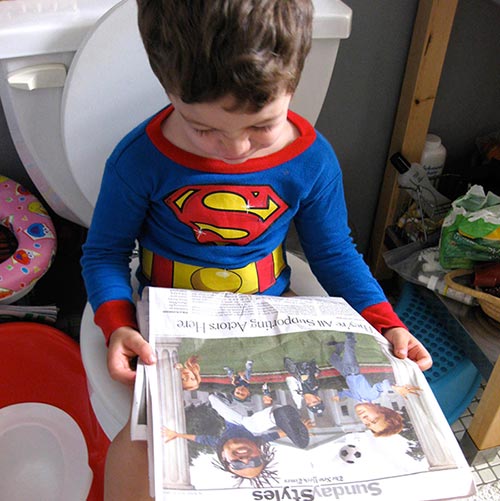Good intention is one of the most important ingredients when undertaking the task of helping your child learn to use the bathroom. For most parents this process is fraught with anxiety, questions, and conflicting advice. When should you start? How should you start? What if you start too early? What if you start too late? It really doesn’t have to be so hard if you accept that this milestone in independence and control is one that can only be accomplished by your toddler. Your role is to provide the conditions that will allow this development to occur.
What Parents Can Do: Provide the Best Conditions Possible
Moving Away from Disposable Diapers
To start, babies can wear cloth diapers until they are crawling, at which point they can then use underwear instead of disposable diapers. Why? Because when a baby is wearing a cloth diaper, the sensation of urination is something s/he can become aware of by feeling the wetness. Disposable diapers naturally delay this awareness. When a child urinates in a disposable diaper, the wetness, as advertised, is pulled immediately away from the baby’s skin, robbing him or her of the opportunity to become aware of the result of urination.
Exposure to the Toilet
Another way that you can help your baby develop awareness related to using the bathroom is to expose him or her to the toilet as soon as s/he is able to sit up. To start, bring the child to the toilet on a regular but not overwhelmingly frequent schedule: upon waking and after meals. At this point, simply help your child get settled on a potty chair or a smaller seat that goes on an adult toilet seat. Help him or her to maintain balance and simply sit for a few minutes with him or her. By following this simple schedule you will begin to build into your toddler’s awareness when s/he is likely to need to use the toilet.
Dressing & Undressing
Another important aspect of this period is the process of dressing and undressing. Be certain to involve your toddler in accomplishing this work. A small bench in the area of the bathroom can be helpful. Your baby can be more successful helping if s/he is able to sit while undressing and dressing. Before using the toilet, you should remove his or her pants and underwear completely. Even at this young age, your baby will make an effort to help if you are patient enough to give the time and observant enough to recognize his or her attempts. At the beginning, you might ask your child to lift his or her leg while you take off underwear or ask your child to pick up the underwear when you are ready to put them back on. Remember to give your child the time to process your request and then execute the action. Encourage these efforts. Acknowledge the learning, growth, and emerging independence.
accept that this milestone in independence and control is one that can only be accomplished by your toddler
It is important to be using the proper language as well. “I am pulling down your pants. You hold on to the bench. Now sit down. Now I am going to take your pants off. Can you lift up your leg?” etc… Be sure to choose loose simple clothing that will allow your toddler to participate in dressing. If s/he is ready to participate in climbing up on to the toilet, provide a stool and assistance. Each of these are little steps along the road to successful use of the bathroom.
What Parents Must Do: Patiently Yield to Your Child’s Will
This stage of building awareness will last for months. The hard part is that awareness cannot be seen or evaluated. It is completely internal to the mind of your child. So even as you are successfully assisting your toddler, you can’t necessarily see any outward indication of progress. But the growth in your child’s developing mind is in fact taking place.
By the time your child is able to walk, all the physiological changes that are necessary to control bodily functions have developed. And from all of the efforts you made previously, your child has already learned much about the process of using the toilet and recognizing the feeling that it is time. It is at this point, however, that you must be your most patient and understanding.
The decision to use the toilet and the learning that is involved in the process is a profound step in the development of the will of the young child. Yes, the will. For a one-year-old child to undertake this process requires the exercise of controlled and determined inhibition. She must first be aware of an urge, and then choose to resist it, until certain conditions are met: when she is undressed and seated on a toilet.
This choice is completely under his or her control. It is an internal process, and we must be cautious not to be unreasonably fixated on the end result. In fact the road is just as important as the destination. If you are able to keep this in mind, then all of the successes that lead up to the ultimate goal will be times to celebrate.



Leave a Comment